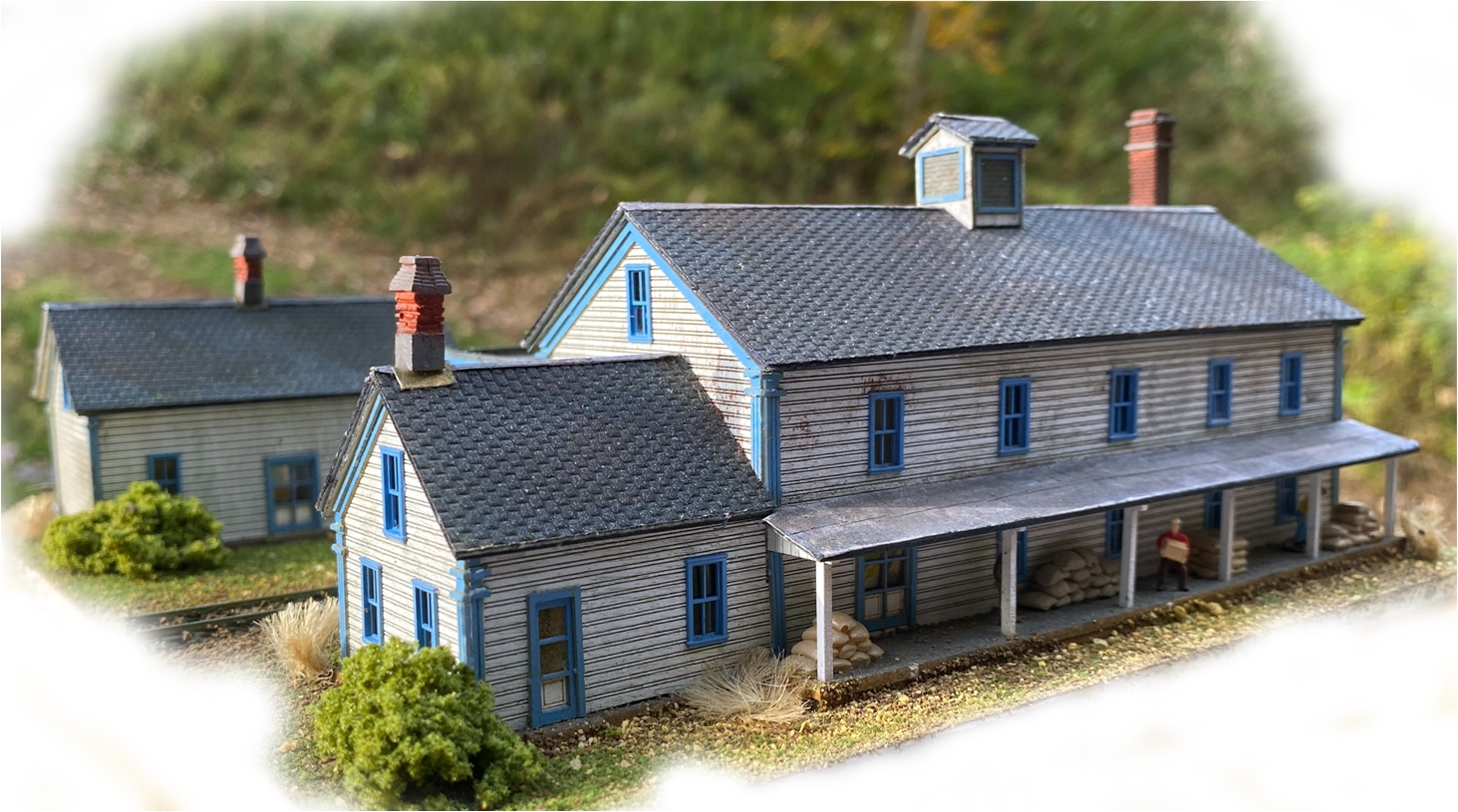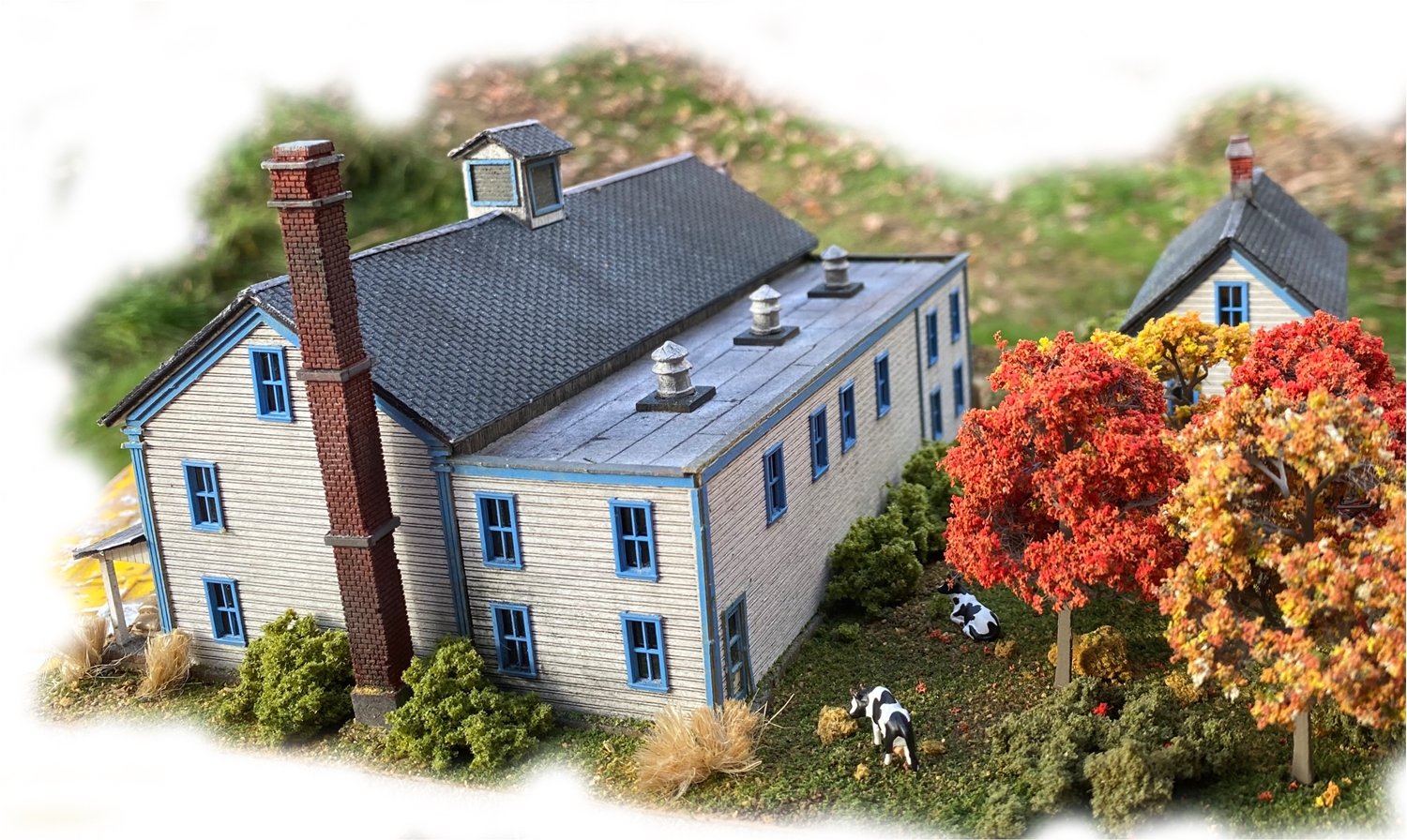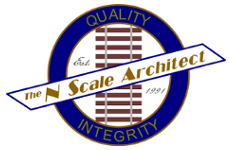Specific Item Information: In 1884 Amos G. Winters built a mill in Kingfield, Maine to grind grain brought in via the Franklin & Megantic Railroad (F&M). The two-foot gauge F&M was absorbed into the infamous Sandy River & Rangeley Lakes Railroad in 1898. Grain was brought to the top floor of this structure via a conveyor where it was stored and then subsequently ground and bagged on the floor below. The finished product was lowered to the first floor via a rope elevator for further transportation to area markets or direct retail sales. Prior to 1916, boxcars filled with grain were brought into a covered structure within the complex for unloading and there was a large central vent on the main roof to exhaust the potentially deadly grain dust.
We chose to model this period of time due to its stronger ties to the railroad and made provisions for unloading standard gauge (versus smaller narrow gauge) boxcars. Windows were added to the otherwise barren walls at the rear of this complex and the separate storage shed, which was originally part of this complex, is also included. Overall, this kit is a good representation of the prototype during this period of history. You can still find this structure along Depot Street in Kingfield, Maine where it has been repurposed as a health center (2016).
This highly detailed kit features laser-cut micro-plywood components, multiple roofing materials, an interior support system and illustrated step-by-step instructions. Complete your scene or diorama with our sack, barrel and crate assortments and vehicle kits. The completed model measures approximately 7″L x 4 ¼”W x 1½”H. See Plan View Diagram for more detailed dimensions.
We chose to model this period of time due to its stronger ties to the railroad and made provisions for unloading standard gauge (versus smaller narrow gauge) boxcars. Windows were added to the otherwise barren walls at the rear of this complex and the separate storage shed, which was originally part of this complex, is also included. Overall, this kit is a good representation of the prototype during this period of history. You can still find this structure along Depot Street in Kingfield, Maine where it has been repurposed as a health center (2016).
This highly detailed kit features laser-cut micro-plywood components, multiple roofing materials, an interior support system and illustrated step-by-step instructions. Complete your scene or diorama with our sack, barrel and crate assortments and vehicle kits. The completed model measures approximately 7″L x 4 ¼”W x 1½”H. See Plan View Diagram for more detailed dimensions.
Road Name History:  Commercial structures are any buildings or other man-made structures whose principal purpose is trade. These can be high-rise officer towers, gas stations or fruit stands. Any structure where end-user customers come to buy things from sellers of that product or service are consider commercial structures.
Commercial structures are any buildings or other man-made structures whose principal purpose is trade. These can be high-rise officer towers, gas stations or fruit stands. Any structure where end-user customers come to buy things from sellers of that product or service are consider commercial structures.
This group will therefore include quite large as well as quite small buildings. Models of these buildings might be kits or pre-assembled. They might be painted or undecorated. They might come with a host of accessories and figures or they might be fairly Spartan.

This group will therefore include quite large as well as quite small buildings. Models of these buildings might be kits or pre-assembled. They might be painted or undecorated. They might come with a host of accessories and figures or they might be fairly Spartan.
Brand/Importer Information: The N Scale Architect was founded in 1991 by Russ Kaufman who has been active in model railroading since the early 1970s. Although many model railroaders received a Lionel Train as their first train set, Russ and his brother Bill were bitten by the model railroad bug in the form of an Aurora N-Scale set.
Russ started The N Scale Architect based on the encouragement of fellow modelers who thought that the plans he had drawn up for scratch building over the years might be enjoyed by others in kit form. The first kits featured detailed step-by-step instructions with hand drawn illustrations and plastic templates to be used for cutting the various pieces. This tradition of high quality instructions continues with the addition of "in-process" and color photos and, thanks to better computer aided programs, more detailed drawings. These templates have been replaced with laser-cut micro-plywood pieces along with the addition of many detailing castings which are now also available separately as part of their "Making A Scene" product line.
Russ started The N Scale Architect based on the encouragement of fellow modelers who thought that the plans he had drawn up for scratch building over the years might be enjoyed by others in kit form. The first kits featured detailed step-by-step instructions with hand drawn illustrations and plastic templates to be used for cutting the various pieces. This tradition of high quality instructions continues with the addition of "in-process" and color photos and, thanks to better computer aided programs, more detailed drawings. These templates have been replaced with laser-cut micro-plywood pieces along with the addition of many detailing castings which are now also available separately as part of their "Making A Scene" product line.
Item created by: CNW400 on 2024-12-11 15:57:40
If you see errors or missing data in this entry, please feel free to log in and edit it. Anyone with a Gmail account can log in instantly.
If you see errors or missing data in this entry, please feel free to log in and edit it. Anyone with a Gmail account can log in instantly.




